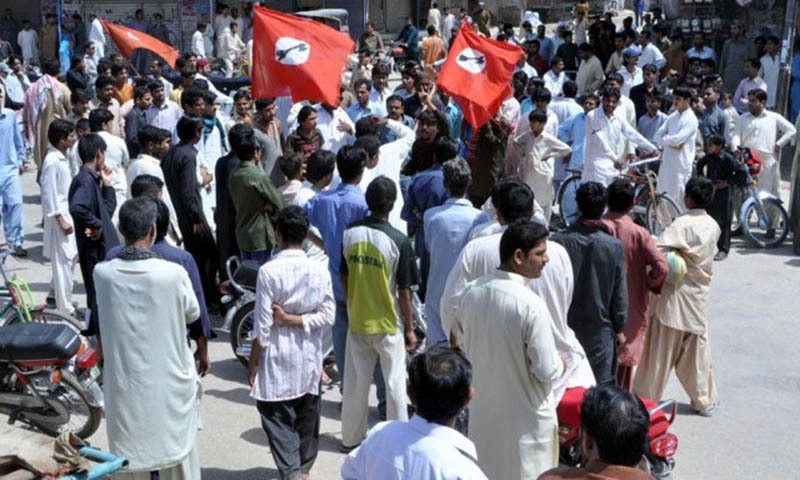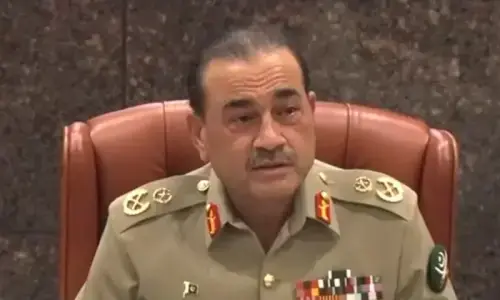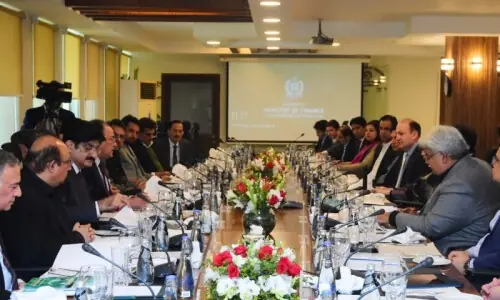OVER the past few days, there has been an uptick in the number of bodies found in different parts of Sindh and Balochistan of men reportedly belonging to Sindhi nationalist groups. They had earlier been picked up by unidentified individuals.
Yet despite these grim discoveries and the overall poor state of governance in Sindh, nationalist groups remain as divided as ever, with some opting to shun the political process in favour of violent struggle in reaction to alleged persecution from the security establishment.
Also read: Nationalists plan drive against IDPs entry into Sindh
The nationalists have been unable to fill the political vacuum in Sindh created by years of bad governance by the Pakistan People’s Party. For example during the 2010 ‘super flood’ and the recent drought in Thar, the nationalists were nowhere to be found. In the absence of a clear strategy the nationalist groups that emerged out of G.M. Syed’s Jeay Sindh Tehreek (JST) have been busy in issue-based politics. This has turned them into pressure groups, not effective political parties.
The genesis
The nationalist movement was launched in the 1950s to struggle against One Unit. After 1971’s Bangladesh debacle, G.M. Syed gave a new direction to nationalism and founded the JST in 1972 and presented the idea of Sindhudesh — a separate homeland for Sindhis.
Syed laid the ideological basis for his movement but did not concentrate on organisation and political training of his party’s cadres. As a result, the movement became divided into three groups within Syed’s lifetime. Now there are nearly a dozen groups all laying claim to the Jeay Sindh mantle.
A Marxist activist in the Jeay Sindh camp, Dr Arbab Khuhawar, was the first to part ways with Syed, saying the nationalist movement should have a socialist orientation. Khuhawar formed the Sindh Watan Dost Party, based on socialist ideology, in 1979. His party played an active role in the 1983 Movement for the Restoration of Democracy but eventually disappeared from the political scene.
Two currents were simultaneously working in the JST, one led by Dr Hameeda Khuhro and another by Abdul Wahid Arisar. The one led by Dr Khuhro was dominated by feudals, while Arisar and others came from the working or middle class, who had read extensively on socialism and national liberation movements and wanted to make the JST a party of the common man. The other faction, Jeay Sindh Mahaz (JSM), was further divided into two groups led by Bashir Khan Qureshi and Arisar in the early nineties.
Syed died in 1995. His death brought all factions of the JST under one umbrella and the Jeay Sindh Supreme Council was formed. However, a faction led by Khaliq Junejo did not join this merger and continued to work under the banner of the JSM.
Later, groups led by Arisar and Qureshi formed the Jeay Sindh Qaumi Mahaz (JSQM). This unity continued for five years, with Arisar and Qureshi parting ways in 1999. The point of difference, apart from other things, was Arisar’s soft corner for an organisation working for Mohajirs, or Sindh’s Urdu-speaking settlers.
Among the Jeay Sindh factions, the JSQM became popular over the years. Qureshi hailed from Naudero, and in his student years was an active member of the Jeay Sindh Students Federation (JSSF) at the Sindh Agriculture University in Tando Jam. His understanding of local politics did not come from the study of political literature, but from his frequent travels to every nook and corner of the province. He organised large public meetings and ‘long marches’ to Karachi, thus succeeding in mobilising a section of Sindhi society.
Crucially, he was able to shift the centre of nationalist politics from Hyderabad to Karachi. His death under mysterious circumstances in April 2012 and later the death of his brother Maqsood, who was made his successor in the party, diminished the group and consequently the nationalist movement.
The leadership of this faction has been handed over to Bashir’s son Sanaan, a young man who observers say lacks political training and experience. Mutilated bodies of its activists have recently been found in different parts of Sindh.
Though G.M. Syed opposed parliamentary politics after the 1970 elections, his family members did not disown the legislature. His sons Syed Imdad Mohammad Shah and Syed Amir Haider Shah were elected MPAs in 1985 and 1992, respectively. His grandson Syed Jalal Mahmood Shah has regularly been contesting elections since the 1990s and leads the Sindh United Party.
The militant path
Another group known as the Jeay Sindh Muttahida Mahaz (JSMM) believes in armed struggle. Though it is not that popular, during the last 10 years it has expanded its reach to universities. Bomb blasts attributed to the banned JSMM by the police have been reported at intervals in different parts of Sindh. News of its young activists disappearing and later their mutilated bodies being found in deserted places is being reported regularly.
The Sindh Taraqqi-pasand Party (STP) was formed by Dr Abdul Qadir Magsi in the early nineties when he differed on the Mohajir issue. In the beginning, the party believed in achieving its goals through armed struggle. Dr Magsi was critical of Syed’s strategy of boycotting parliamentary politics, stating that it caused loss to the nationalist movement. Dr Magsi hails from Thatta and began his political career when he was a student at the Liaquat Medical College; he gained popularity after the JSSF clashed with the New Sindhi Organisation, a students’ body of Punjabi settlers. Ethnic polarisation and strife in Sindh prevalent at the time further strengthened his popularity. This faction gained popularity due to its militant stance in the 1990s but over the years its fortunes have declined.
Know more: Qadir Magsi urges JSMM to give up armed struggle in Sindh
JSMM chief Shafi Burfat, previously an important STP figure, parted ways with Dr Magsi in 2000. The point of departure was Dr Magsi’s adopting of a soft line towards parliamentary politics. Burfat hails from Jangara Bajara, a hilly area near Sehwan Sharif. He is from the Burfat tribe, whose chieftain is Malik Asad Sikandar.
Two other factions led by Junejo and Arisar are also active but are busy in issue-based politics. According to observers, they are becoming irrelevant in practical politics. Arisar hails from Thar and studied in a seminary near Hyderabad. A man of literature and history, he tried linking the nationalist movement with a historical perspective.
Challenges ahead
According to a JSQM leader, “Many developments have taken place at the national and international levels over the past 25 years. There is now a middle-class section of Sindhi society with the province undergoing rapid urbanisation. A new narrative and strategy is needed for the changed circumstances.”
Dr Magsi says: “Ideologically and politically the nationalist movement is strong but organisationally it has become weak. Sindhi nationalists will gain importance once they prove their strength through the vote.”
Commentators add that Sindhi nationalists need to take into account that with increasing levels of unemployment, coupled with a relatively high literacy level in Sindh, a sense of deprivation is rising among Sindhis. Moreover, religious extremism and the recovery of mutilated bodies are creating the conditions for militancy, even among those in political circles and civil society who otherwise oppose violence.
Published in Dawn December 4th , 2014




































